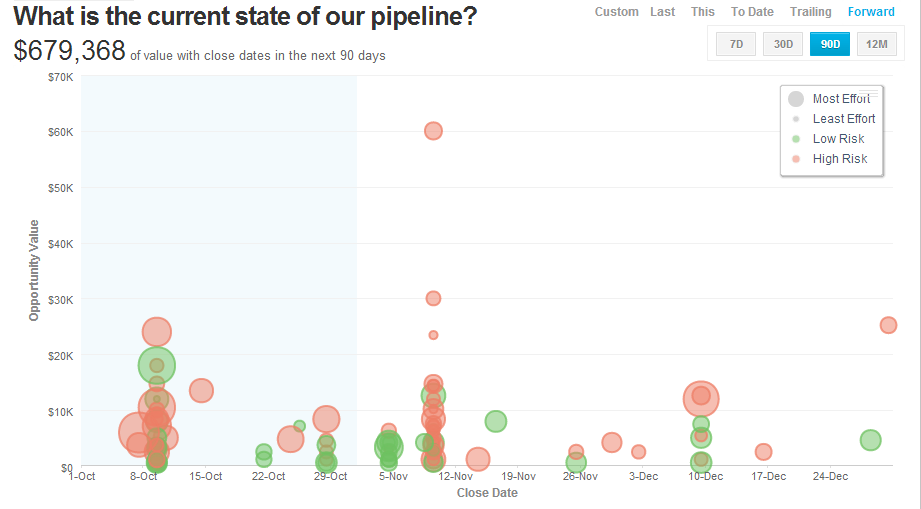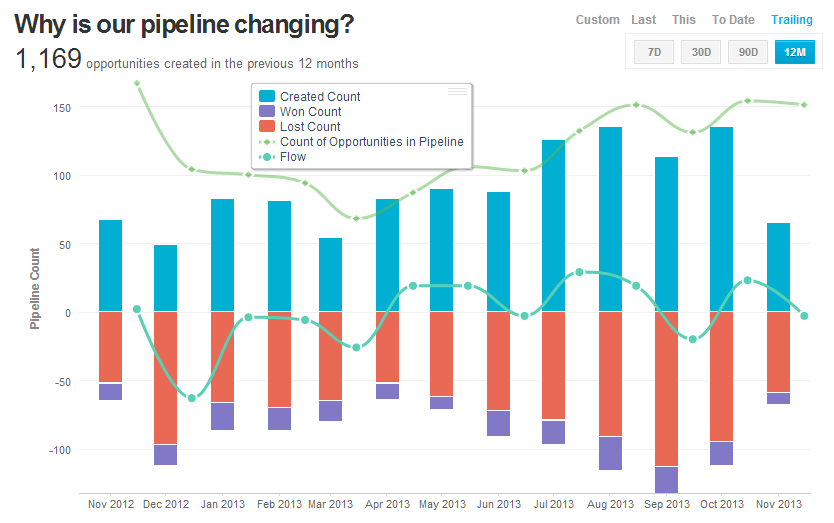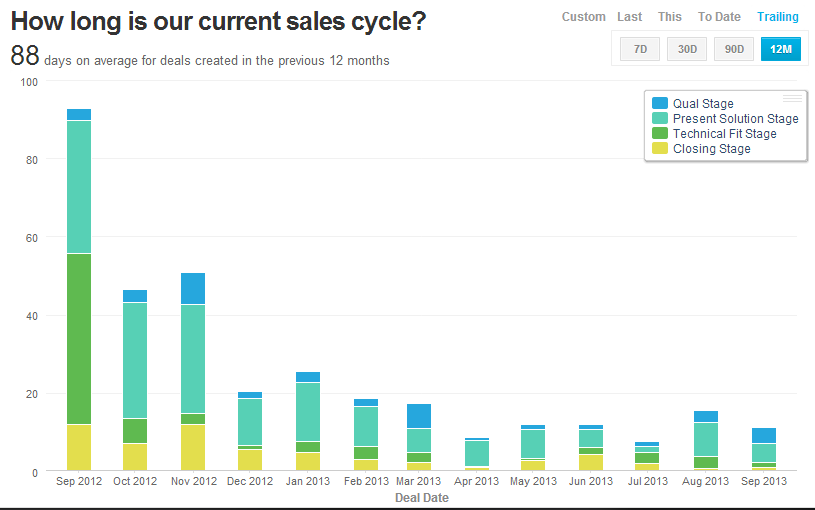

Sales VP: Here’s How To Grow Sales in the Next 6 Months
Originally Posted on VentureFizz Sales BlogIf you’re a couple of quarters into the year and your sales team is not attaining their goals or quota targets, here is what you can do.
Use the framework of focusing on the 5 key elements of sales management or the 5 P’s – People, Planning, Process, Pipeline and Performance – to help identify ways to grow sales
People
To grow sales, you need enough quota-carrying reps. Do you have enough reps to work your sales pipeline and hit your quota for the next 6 months? Are these sales reps full-time equivalents (FTE), or are they new and need to be trained? Remember, it usually takes about 4 months for new hires to get fully productive. Do you have an efficient training and on-boarding program for new hires in place? If you don’t have enough reps, you need to hire quickly or you won’t make your sales number in 2014.
Make sure your reps are sufficiently trained on your correct sales processes that matches the buying process of your target market. Also, ensure that they’re receiving regular sales coaching which should be individually tailored to each rep and rely on sales analytics to measure improvements.
Planning
Quite simply, do you have a sales strategy that works and are your goals achievable?
Sales strategy defines a) WHO are your customers, b) WHAT is the value of your product to these customers and c) HOW are you going to sell to these customers. You need a sales strategy that works, meaning that WHAT you are selling is properly aligned to your Ideal Customer Profile (ICP) and that HOW you are selling to these (the go-to-market) is aligned to this ICP and to the type of product that you are offering.
Additionally, are your goals achievable and have you planned effectively to ensure your sales team size and skillsets are aligned well to hit these goals? Are you sure you have enough FTEs and are your reps trained well to sell your product? Do you have enough quota-carrying reps to hit your number in Q3 and Q4? Have you shared your plan with your marketing VP to ensure that marketing contributes to the pipeline and to help you hit your goals?
Process
A recent survey published by CSO Insights revealed that companies with a formal sales process – which is defined and regularly reviewed to ensure sales effectiveness – have substantially better performance than those with ad hoc or informal sales processes. While this might seem like a no-brainer, the CSO Insights report suggests that a vast majority of companies are still working by the seat of their pants when it comes to formalizing, reviewing and measuring their sales processes.
Don’t make this mistake at your company.
Implement a formal and defined sales process that is matched up to buying stages, rather than your reps’ selling stages. Ensure that the process is written down and is well-known by every member of your team. Finally, don’t forget to review this process regularly, using your sales analytics to make sure that the process is working effectively. An improved and more effective sales process will help you grow sales in the 2nd half of 2014.
Pipeline
For starters, you need to review your historical pipeline by month through the first half of 2014. Is the opportunity count trending up or down? Did you have more opportunities in Q2 than you did in Q1 and what was the Win rate on those? And are there enough opportunities in your sales pipeline now to hit Q3 and ultimately Q4 goals? Also, looking at your historical closed-won conversion rates from your pipeline for the trailing 12 months will let you know if you have the proper sales coverage ratio (i.e. pipeline-to-quota ratio) that you’ve experienced. Instead of simply adhering to the industry standard of 3x coverage ratio, examine your sales team’s historical performance to discern what your true pipeline-to-quota ratio should be. One key consideration here is to analyze larger deals separately, as they typically have longer sales cycles, more internal buyers, etc. If most of your pipeline for Q3 consists primarily of larger deals (2x of your average deal size or greater) and if you typically have a transactional business composed of smaller $ASP deals then you will have to do some drastic lead generation to rectify this problem and balance out your pipeline.
From there, you should study reports showing the Inflow/Outflow of opportunities in and out of your sales pipeline. This report displays the opportunities created each month (the inflow into the sales pipeline) compared to the deals that were Won or Lost (the outflow from the sales pipeline). What’s your net inflow here? How many of these opportunities are still open and carrying over into the next quarter? If you did not have growth in Inflow over the past few months then this should inform you of where you stand with regard to Q3 and that you should urgently execute lead generation campaigns to quickly remedy the situation you’re in.
Also, break down your Win Rate % by small deals vs. large deals to see if your Win Rate % on larger deals is good. If your Win Rate % for larger deals is small then you should remove the larger opportunities from your pipeline count to have a better and clearer picture of what your pipeline looks like only with your core business opportunities.
Finally, a big aspect of the sales pipeline is your marketing team whose responsibility is to contribute to the pipeline. Analyze your pipeline Inflow/Outflow to discern how much marketing is contributing to new business opportunities. Are you getting enough high-quality opportunities that originated from Marketing Qualified Leads (MQLs)? Also, have you enabled and activated your channel partners to contribute to the pipeline?
Performance
If the performance of the sales team is not up to par then everything else won’t matter. Look back at the first half of 2014 and look at whether the team hit their goals or if these goals were set unrealistically high? To answer that, you must do a top-down and bottom-up analysis and build an operating model for your business (as well as a sales capacity model) that will help you evaluate if your goals for the 2nd half are unattainable. If the goals for the 2nd half are unattainable based on the operating buildup then it’s your job as a Sales VP or a sales manager to talk to your CEO about adjusting expectations.
If you cannot get goals expectations reset then you should look into a couple options. Firstly, you should work proactively with marketing to immediately launch new lead generation programs and focus on campaigns that have the best conversions. Additionally, work with your most active channel partners more since referred leads have better conversions and lead velocity. Finally, go after larger deals with high average sale prices that can help you hit your sales quota goals.
Also, analyze your Win Rate %. How does your Win Rate % compare between Q1 and Q2? Are things ticking upward? What are your sales funnel conversion rates like in each quarter? Where are the specific areas of weaknesses? Are there particular stages where your reps are struggling to convert?
Instead of just zeroing in on your overall Win Rate %, break it down to Win Rate % by small deals vs. large deals to see if your Win Rate % on larger deals is good. Then your marketing team should be focused on these more valuable opportunities but if your Win Rate % for larger deals is very small then you need to train your sales team on consultative sales or bring more seasoned reps to handle these deals. Of course, if your product is not built for larger clients then it’s a different story altogether and you should avoid these deals. Similarly, look at your Win Rate % cohorted by both Created Date (a lagging indicator) and Close Date (a leading indicator). Both are equally important to consider in your sales analysis.
Finally, did your sales cycle shorten between Q1 and Q2? If the sales cycle is somehow growing, you should understand why this is happening. Longer sales cycle can make it more difficult for you to hit your sales goals over the next 6 months. Is this a marketing problem (handing over unqualified leads to the sales team) or a sales problem (underperforming reps)?
Growing your sales over the next 6 months is no easy feat. There will be many challenges, both internally and externally, that threaten to hold your company back. However, looking at the first two quarters of 2014 through the prism of the 5 P’s – People, Planning, Process, Pipeline and Performance – can provide incredibly meaningful insights that, if properly implemented and acted upon, can substantially grow your sales and improve your performance over the rest of the year. Those that don’t learn from history are doomed to repeat it, so take stock of the past six months and grow over the next six.
Zorian Rotenberg is the VP of Sales & Marketing at InsightSquared. You can find this blog post, as well as additional content on the InsightSquared blog. You can also follow Zorian on Twitter (@Zorian) by clicking here.



